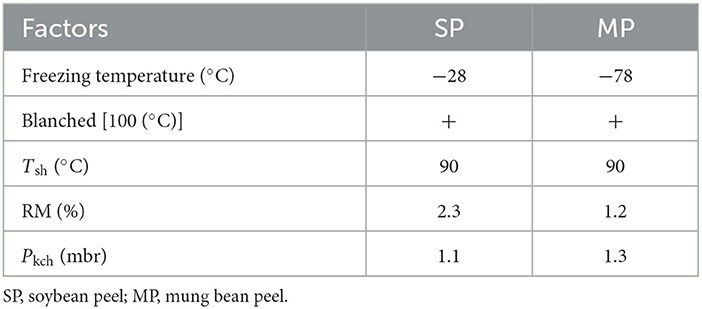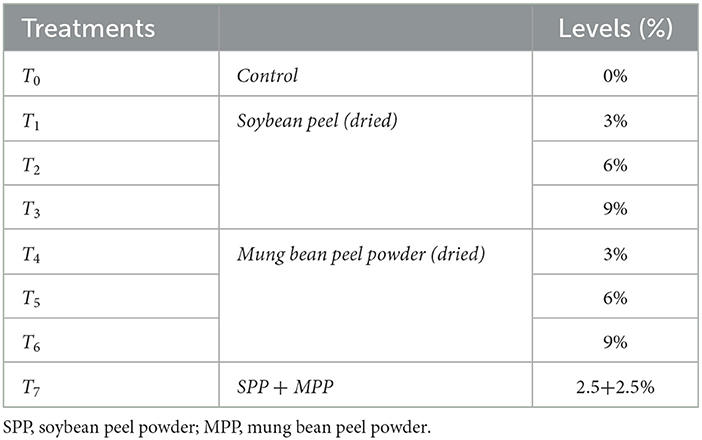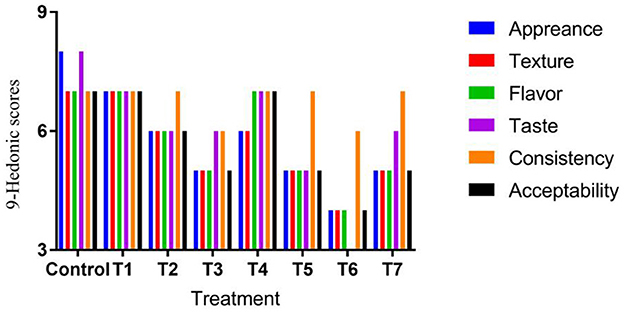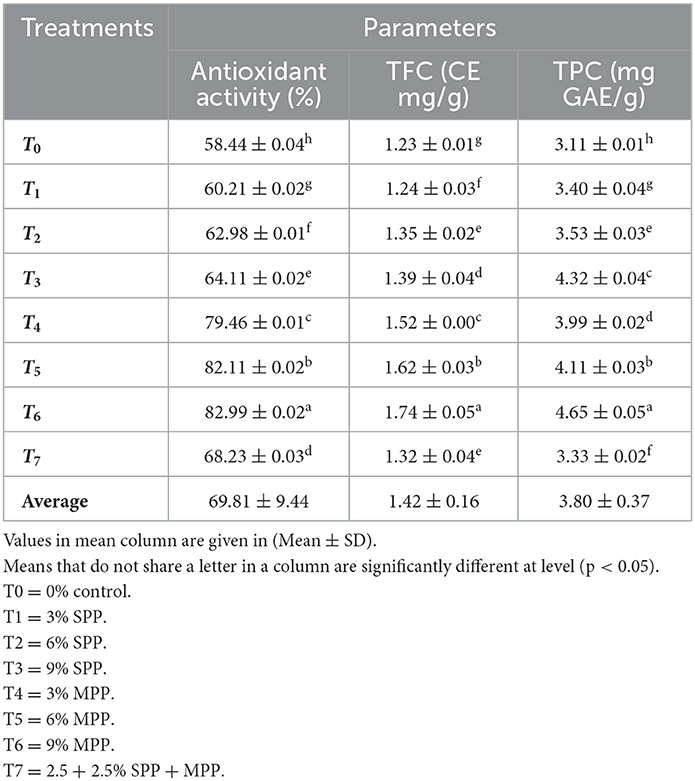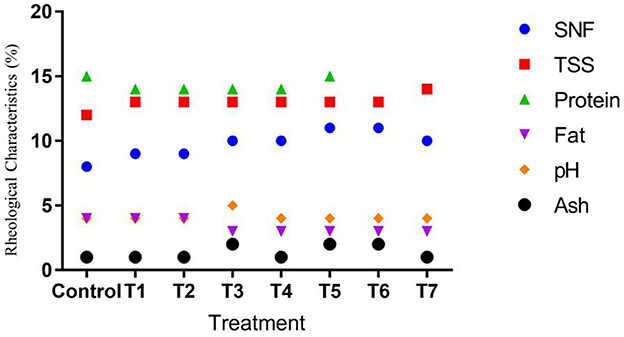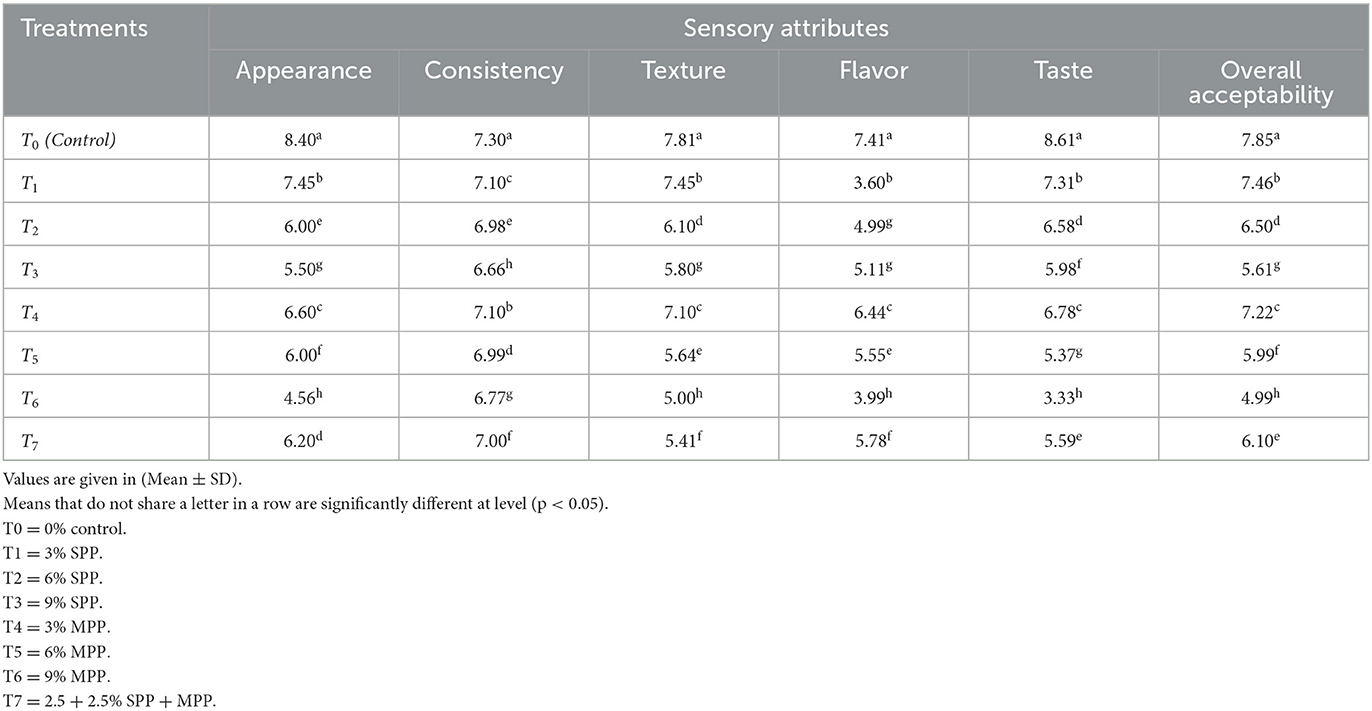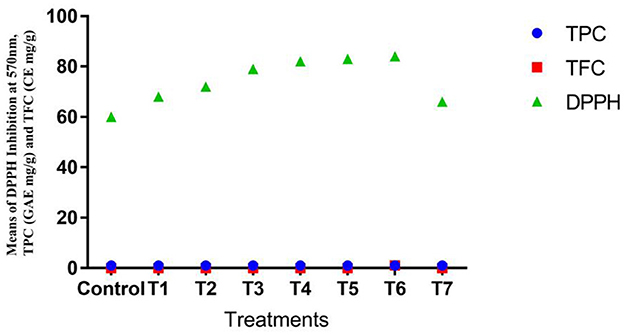- 1Joint International Research Laboratory of Agriculture and Agri-product Safety, The Ministry of Education of China, Institute of Agricultural Science and Technology Development, Yangzhou University, Yangzhou, Jiangsu, China
- 2Department of Occupational and Environmental Health, Xiangya School of Public Health, Central South University, Changsha, China
- 3Food and Nutrition Society, Gilgit Baltistan, Pakistan
- 4Department of Food Science, Government College University, Faisalabad, Pakistan
- 5Belrosakva Limited Liability Company-Direktor, Minsk, Belarus
- 6Key Laboratory for New Technology Research of Vegetables, Vegetable Research Institute, Guangdong Academy of Agricultural Sciences, Guangzhou, China
Introduction: Plant-based yogurt has earned much interest in current times due to the rising demand for milk substitutes, which is tied to ethical and health needs.
Methods: Freeze-drying impact on soybean peel powder (SPP) and mung bean peel powder (MPP) and their use in creating functional yogurt at various concentrations was checked. In functional yogurt, total flavonoid content (TFC), total phenolic content (TPC), antioxidant activity and chemical profile are checked.
Results: The maximum concentration of TPC was 4.65±0.05 (mg GAE/g), TFC was 1.74±0.05 (CE mg/g) and 82.99 ± 0.02 % antioxidant activity was calculated in sample T6, having the highest concentration of SPP, which was substantially more significant than the treatment samples containing MPP. Sensory attributes of the yogurt samples were analyzed, which indicated a decrease when SPP and MPP values increased when introduced at 3 or 6 % of an optimum level. There was no notable loss of the sensory profile compared to the control group. The results were found to be significant at p < 0.05. The freeze-dried SPP had the complete chemical composition compared to MPP except for ash and fiber content.
Discussion: The physicochemical profile of the treatments of functional yogurt had a linear proportional connection in the percentage of both powders in the meantime. When both the dry level of powders increased, the protein and fat levels decreased. In the food industry, the freeze-dried soybean peel and the peel of mung bean can be utilized in functional yogurt as a source of bioactive components.
1. Introduction
Phytochemicals, dietary fiber, and other essential components abound in agro-industrial waste. This trash is frequently burnt or abandoned, even though it contains numerous valuable nutrients (Thakur, 2020; Khalid et al., 2022a,b,c). One of the essential industrial wastes, soybean has one of the highest concentrations of dietary fiber, bioactive substances, and other critical elements (Sagar et al., 2018). The phrase “food by-products” has gained popularity throughout time. The word clarifies that biological waste may be appropriately processed and transformed into more valuable compounds for the market (Kour et al., 2019; Trivedi et al., 2020; Ali et al., 2022a).
Because of their nutritional qualities (polyunsaturated fatty acids, dietary fibers, and high-quality proteins) and their critical role in lowering the risk of chronic illnesses, soy and mung bean products are becoming a more significant component of the human diet (Kumar and Pandey, 2020; Ali et al., 2021a; Khalid et al., 2022d). Soy products may promote bone health, alleviate menopausal symptoms, and lower the risk of heart disease, type 2 diabetes and cancer (Pabich and Materska, 2019; Ali et al., 2021b, 2022b; Aziz et al., 2022). But for the sector in question, disposing of the by-products of soy and mung bean food production is a significant challenge. Soybean has various drawbacks, such as an unpleasant bean flavor for particular operations and flatulence caused by their raffinose and stachyose concentration (Hachmeister and Fung, 1993; Li et al., 2022). These two beans contain different essential components like mung bean (25–28% protein) and a resource of bioactive components such as polysaccharides, phenolic acids, organic acids, and flavonoids (Kim et al., 2016).
Despite being somewhat more expensive than other drying procedures, freeze-drying yields the finest quality food product attainable (Ishwarya et al., 2015; Ali et al., 2022a). Microwave freeze-drying and atmospheric freeze-drying are two other kinds of freeze-drying that are often employed in the food business (Duan et al., 2016; Ahmed et al., 2022; Maqbool et al., 2022). Due to the elimination of water content in materials by sublimation in both ways, the product quality of these two drying techniques is comparable to that of freeze-drying. Even though there has been a lot of scientific studies done on drying methods, studies have shown that freeze-drying is more efficient (Abdelwahed et al., 2006; Ahmed et al., 2022; Ahmad et al., 2023).
Products that have been freeze-dried retain a large portion of their original flavor and phytochemical qualities (Mustafa et al., 2019). They are also found to be both exceedingly light and crunchy. Since each organic substance (food) has unique features and various requirements, no specific moisture removal procedure is suitable for all kinds of food products (Malode et al., 2021; Khalid et al., 2022a; Manzoor et al., 2022). There is an urgent need to cease squandering and burning these nutrient-dense by-products that can be easily incorporated into new goods to compensate for nutritional shortages in present goods and extend the shelf life (Hansbro, 2023).
This research aims to verify that peel powders from soybean and mung beans may be used to create fermented functional foods high in fiber, like yogurt. The bioactive potential of the freeze-dried soybean and mung bean peel powder has been investigated at several phases of the yogurt production process.
2. Materials and methods
2.1. Raw material procurement
Raw milk, soybeans, and mung beans were purchased from the local market of Lahore city. To prevent contamination, milk, soybean and mung bean were placed into plastic bags. Additionally, the raw materials were sent to the Department of Food Science's fruits and vegetable laboratory at Government College University Faisalabad for additional evaluation.
2.2. Handling of raw material
The laboratory was supplied with milk, mung beans, and soybeans for processing.
First, distilled water was used to wash the soybean and mung bean properly. While removing the peel from the soybean and mung bean, the milk container was stored in a 7°C refrigerator.
2.3. Drying of soy and mung bean peel by freeze-drying
With some necessary adjustments, the freeze-drying method, as suggested by Fischer et al. (2011) was used to dry soy and mung bean peel. This was accomplished using a laboratory freeze-dryer (ALPHA 1-2 LD Plus, Christ, and USA). As indicated in Table 1, several parameters, including freezing temperature, Pkch (mbr) vacuum pressure, Tsh temperature, and residual moisture level were established for wet soy and mung bean peel freeze-drying. In a freeze-dryer, wet Soy and mung bean peel was also transported for drying. The powders were gathered after drying and kept for further examination at room temperature in aluminum pouches. Soy and mung bean peel were dried, then crushed into a fine powder for future research and the creation of functional yogurt.
2.4. Product development
As stated in Table 2, SPP and MPP were measured, then added to the pasteurized milk but first the milk was inoculated with cultures having Streptococcus thermophiles and Lactobacillus bulgaricus. The mixture was mixed at 46°C and let 12–24 h for fermentation.
2.5. Chemical composition
By measuring the moisture content of dry powder 2 g, precisely., drying it at 100 5°C for roughly 3 h, and then weighing it again, the moisture content was determined. The Kjeldahl and Soxhlet equipment further evaluated the protein and fat levels. Additionally, a 2 g sample was heated to 400°C for 3 h in a muffle furnace under controlled circumstances to determine the sample's ash composition. This particular endeavor also looked into the crude fiber. Meanwhile, the following expression was used to compute nitrogen- or carbohydrate-free extracts:
2.6. Yogurt's bioactive characterization
2.6.1. Extraction of sample
Utilizing the 9,676.8 g in a KMF grinder (grinder used to grind cereals like beans), freeze-dried soy and mung bean peel samples were reduced to powder. Before further extraction, prepared grounded samples were stored at 40°C in sterile bags to avoid contamination. To make the extracts, ethyl alcohol, methyl alcohol, and water were used. A flask with 100 mL of ethyl acetate was precisely filled with 0.5 g of dry material and then swirled for 3 h at 20°C. A Harrier 18/80 refrigerated centrifuge (MSE, UK, SANYO) was used to spin the mixture at 9,676.8 g for 30°C. Furthermore, the supernatant was filtered using Whitman filter paper (No. 1, 155 mm). The obtained extracts were stored at 4°C for further testing.
2.6.2. Antioxidant activity
Antioxidant activity was evaluated using the technique (2,2-diphenyl-1-picryl hydroxyl) described by Fischer et al. (2011), with specified minor adjustments. For this, precisely 15 ml of the extracts were put into a test tube along with 750 mL of the 0.1 mM DPPH and 735 mL of methanol solution. Everything was well homogenized until the section was completely dissolved in the methanol. The mixture was stored in the dark for exactly 30 min to avoid exposure to light. The absorbance at 517 nm was measured using a UV-visible spectrophotometer (Madison, ermo Scientific Technologies, WI, USA). The findings were presented as mg of extracts corresponding to mM ascorbic acid (AA).
2.6.3. Total phenolic content
According to Donkor et al. (2007), using the Folin-Ciocalteu technique, the TPC (total phenolic content) of the extracted materials was evaluated. This was done by carefully adding 250 mL of the Folin-Ciocalteu reagent, 750 mL of Na2Co3 (1.9 M), and 70 mL of the generated extracts to a test tube with a 10 mL capacity. A volume of precisely 5 mL was created by adding distilled water. This volume was then combined for roughly a minute in a vortex mixer before being kept in the darkness. The absorbance was estimated via a spectrophotometer (Surrey, England's Ermo-Spectronic) at a wavelength of 765 nm. The result was represented in mg dry solids of gallic acid equivalents (GAE).
2.6.4. Total flavonoid content
Using a procedure stated by Xu and Chang (2009), TFC was determined for mung bean peel and freeze-dried soybean extract. To prepare the extract, 4 mL distilled water in a test tube of 10 and 1 mL of the obtained extract were used. After this, 0.3 mL of 5% sodium nitrite was added to the test tube. After 5 min, 0.3 mL aluminum chloride of 10% was added to the test tube. 2 mL of 1 M sodium hydroxide has been added to the test tube and thoroughly homogenized. Now, 2.4 mL of clean water was quickly used to dilute the test tube, and it was mixed correctly. Next, At 510 nm, the pink mixture's absorbance was measured using water as a reference. To produce a reliable calibration curve, several catechin solution mixtures were used. The findings were represented in mg of catechin equivalent (CE) for each gram of dry solids.
2.7. Syneresis analysis
Falcon tubes containing precisely 5 mL of sample were centrifuged at 500 rpm for 15–20 min at 4–5°. Within 1–2 min, the whey was separated. The volume of whey separated per 100 mL of yogurt was used to express the quantity of whey. The syneresis was evaluated and measured during 0th, 7th, 14th, and 21st.
2.8. Sensory evaluation
The sensory evaluation of yogurt samples used a 9-point hedonic scale for the research. A panel of several qualified judges with expertise in the study's topic evaluated sensory qualities. E.g., parameters on the scale were as follows:
1 = dislike, 2 = dislike slightly, 3 = neither like or dislike, 4 = like moderately,
5 = like very much, 6 = like extremely, 7 = good, 8 = very good, and 9 = excellent.
2.9. Statistical analysis
The collected data were imported into SPSS for variance analysis (ANOVA). The significance level among the obtained mean values was determined using Duncan's Multiple Range (LSD) test.
3. Results
3.1. Compositional analysis
The average protein content of yogurt was (14.55 ± 0.67)/100 g, while 15.12 g was the highest we found in T0 with 0% dried MPP and SPP. The T6 sample with 9% freeze-dried MPP had the lowest protein content (13.89)/100 g. The fat analysis reveals that the average amount of fat in 100 g of yogurt was (3.93 ± 0.38) g, with the maximum amount (4.11/100 g) observed in T0 sample with 0% freeze-dried SPP and MPP and the lowest value (3.71/100 g) found in T7 sample with 9% MPP. Yogurt had total soluble solids in an average amount of (13.55 ± 0.35) w/w, found by Brix determination, the T6 (13.98% w/w%) sample containing 9% freeze-dried MPP had the largest quantity. While the T0 sample had (12.88)w/w% TSS content which is lowest at 0% freeze-dried powder. The solid and non-fat content of yogurt had an average value (10.17 ± 60)w/w% and the most significant amount (11.18)w/w% was found in T6 with 0% dried SPP and MPP, whereas the least (8.98 ± 01)w/w% SNF content was calculated in T0 sample with 0% freeze-dried MPP and SPP. To determine the acidity of milk pH analysis was performed and give H+ content or uptake in milk. The relationship between acidity and pH levels had simply a rough estimate. The pH analysis demonstrates that yogurt has pH value on average (4.52 ± 04). In contrast, the largest value was identified in T3 (5.55) sample with 9% freeze-dried SPP and the lowest pH value was analyzed in T6 (4.11 ± 01) sample with 9% MPP.
The ash level of the functional yogurt produced was evaluated where the ash concentration of furnace oil after it has been completely burned reveals the non-combustible portion that left. This was conducted to assess the quantity and makeup of minerals (Inorganic mass) in food. According the analysis of the ash, the average ash content was (1.97 ± 0.16)/100 g of yogurt. T6 had the highest value of ash (2.22 ± 01)/100 g with 9% freeze-dried MPP and control (T0) had the minimum value (1.75 ± 01)/100 g with 0% dried powder. The chemical composition of yogurt are depicted in Table 3.
The average chemical composition of SPP and MPP has been displayed in Table 4, showing that MPP samples had higher levels of ash (2.45), carbohydrate (57.14%), moisture (7.43)/100 g, and fiber (23.43), in comparison to SPP samples. SPP samples were discovered to have the maximum fat (1.12/100 g) contents and protein (8.53/100 g).
Except for protein and fat levels, the SNF, ash, Brix, and pH values of various treatments tended to rise when MPP or SPP concentrations increased (Figure 1). Furthermore, putting freeze-dried MPP components to the created functional yogurt elevated levels much higher than SPP integrated treatments (p < 0.05).
3.2. SPP and MPP bioactive potency
In Table 5 the bioactive potential of MPP and SPP have been exhibited which reveals that MPP samples had considerably greater TFC (26.151.0) CE mg/g levels and TPC (221.771.79) mg GAE/g content. On the other hand the SPP samples had lowest TFC (8.400.13) CE mg/g and TPC (52.361.22) mg GAE/g.
3.3. Functional yogurt's bioactive profile
The descriptive analysis reveals average (3.80 ± 0.37)mg GAE/g concentrations in Table 6 for the TPC study. However, in T6 the highest concentration (4.65) mg GAE/g was found with 9% freeze-dried MPP, while in T0 the lowest TPC (3.11) mg GAE/g was found with 0% freeze-dried powder. The results of the TFC examination showed average (1.42 ± 0.16) CE mg/g values. The maximum TFC value (1.74) CE mg/g with 9% freeze-dried MPP was examined in T6 sample, whereas in T0 (Control) with 0% freeze-dried powder, the minimum TFC level was examined (1.23) CE mg/g. According to tests for antioxidant activity, an average of (69.81 ± 9.44)% was found. Furthermore, the highest DPPH inhibition or antioxidant activity with 9% freeze-dried MPP was detected in T6 (82.99). In comparison, the lowest DPPH inhibition or antioxidant activity sample with 0% freeze-dried powder was detected in T0 (Control) (58.44)%, as presented in Figure 2.
3.4. Syneresis in functional yogurt
Using a technique described in the materials and methods, prepared functional yogurt samples made up of (T0, T1, T2, T3, T4, T5, T6, and T7) were examined for their syneresis at various time intervals (day 0, day 7th, day 14th, and day 21st). Descriptive analysis was carried out, although the highest concentration was seen and measured in T0 (1.92 ± 0.00)/100 g during the 21st day of storage. The lowest Syneresis concentration was seen and calculated in T6 (1.42 ± 0.00)/100 g at the first day of storage. Each treatment received three replications, as indicated in Table 7.
3.5. Sensory evaluation
Table 8 shows the results of the created functional yogurt with MPP and SPP at various levels. In terms of descriptive analysis, the highest scores for Flavor (7.41), Consistency (7.10), Appearance (8.4), Taste (8.61), and Texture (7.81), with no *SPP and *MPP concentrations were discovered in T0 (Control) sample. In contrast, the lowest scores for Flavor (3.99), Appearance (4.56), Texture (5.00), and Taste (3.33), with 9% MPP were explored in T6 sample. Overall acceptability ratings were found to be much higher than those of other treatments examined. In this investigation, sensory qualities appeared to diminish as frozen powder concentrations increased. However, by incorporating SPP into yogurt, sensorial ratings did not drop substantially compared to treatments containing MPP. To facilitate comparison, estimated marginal means were calculated and textured for sensory evaluation of samples (Figure 3).
4. Discussion
Food sector creates a lot of waste, such as soybean and mung bean peel (Freitas et al., 2021). Freeze-drying method is used to eliminate moisture from soybean and mung bean peels. This study have been conducted to use peels of two different beans to prepare functional yogurt. Employing freeze-drying, the moisture level of MPP was found to be between 8.3 and 7.9 g per 100 g. When freeze-drying was used, the moisture content was 7.88/100 g. Compared to SPP, MPP samples had the highest fiber 35.19 and ash 3.53/100 g. These findings were noticed as 34.05–39.13/100 g for protein and 3.30–3.41/100 g for ash in MPP samples. TFC (26.15)mg GAE/g and TPC (221.71)mg GAE/g were the greatest in freeze-dried MPP samples, with similar results obtained in methanolic extracts. Thermal treatments are adverse to polyphenols in the food chain, as anticipated by Fischer et al. (2011) and Li et al. (2022).
A study Wojdyło et al. (2007) reported that polyphenolic contents tend to fall dramatically. According to Morais et al. (2018), this could be because most phenolic substances are bound to cell materials. Following drying activities will probably release the related biologically active ingredients from the food, making it more bio-accessible during the extraction technique. Freeze-drying is one of the most efficient and effective dehydration techniques, with enhance shelf life (Fischer et al., 2011; Ahmad et al., 2021), while Jovanović et al. (2020) say that freeze-drying is the greatest approach for preserving phytonutrients and fruit and vegetable powders' bioactivity (Babar et al., 2021). The results of this study suggest that freeze-drying might be employed to enhance the recovery of bioactive substances such as TFC and TPC from mung bean and soybean (Khonchaisri et al., 2022).
The pH level raised regarding the inclusion of SPP, but the pH level decreased dramatically at increasing concentrations of MPP. Similar behavior was reported during the creation of peanut milk fermented curd (O'Rell and Chandan, 2013). Thus, in the context of soybean, the pH likely to rise, resulting in a decrease in the acidity of yogurt, perhaps connected to the diluting effect. Ash contents, Total soluble solid, and solid not fat were dramatically enhanced after adding SPP and MPP in ascending order. Similar rise found in TSS and SNF quantities when fiber-enriched yogurt had developed (Nagaoka, 2019). The addition of SPP and MPP concentration order was found to significantly affect protein and fat levels; The Food and Drug Administration's (FDA) criteria for drinkable yogurt stipulate that it must include, 0.5% non-fat, >8.25% milk (SNF), 2% low fat, and >3.25% yogurt before any further ingredients are added. Yogurt that has been fiber-enriched and contains SPP and MPP falls under the category of low-fat yogurt.
The 21st day of storing, the highest syneresis level was detected and measured in T0 (1.79 ± 0.01)/100 g, T6 seemed to have the lowest syneresis value on day one of storage (1.40 ± 0.01)/100 g. The combination of SPP and MPP decreased syneresis concentrations. Meanwhile, treatments with MPP (1.42 ± 0.01)/100 g showed that treatments containing SPP (1.71 ± 0.01)/100 g had reduced syneresis on 21st day of storage.
T6 with 9% MPP had the maximum TFC (1.74) CE/g and TPC (4.65) GAE/g levels. TPC and TFC levels were considerably higher in the present study when SPP and MPP concentrations in yogurt increased. Meanwhile, the addition of SPP and MPP resulted in a significant increase in bioactive substances compared to adding only SPP. A comparable increased in TFC and TPC chemicals has been reported during the creation of probiotic yogurt enriched with SPP (Yadav et al., 2010). TPC and TFC were shown to be significantly increased by supplementing mung bean peel extracts during the formation of stirred yogurt, with values ranging from 1.11–2.18 mg CE/g to 3.39–5.97 mg GAE/g respectively (Fischer et al., 2011). It was established that the amounts of TPC and TFC in various generated treatments were strongly associated with the levels of MPP and SPP. Additionally, by using freeze-dried MPP, the concentrations of TPC in functional yogurt developed were much greater than freeze-dried SPP. These results were found in engagement with the studies led by Issar et al. (2017) and Wang et al. (2020).
Antioxidant scavenging activity is based on how many phenolic and flavonoid compounds are present in a specific diet. As the previous pattern continued, considerable antioxidant activity was seen as SPP and MPP concentrations increased gradually. SPP and MPP concentrations were shown to be closely linked to the antioxidant activity of various generated treatments. By including freeze-dried MPP, antioxidant activity in generated functional yogurt increased much more than freeze-dried SPP (Issar et al., 2017; Wang et al., 2020). Earlier, findings (Yadav et al., 2010; O'Rell and Chandan, 2013; Wang et al., 2020) highlighted that the addition of SPP and MPP amplifies the antioxidant action of yogurt.
5. Conclusion
In this study, we made functional yogurt with SPP and MPP and tested it for bioactive profiles such TFC, TPC, and DPPH inhibition, commonly recognized as antioxidant activity. Soybean and mung bean peel were freeze-dried first, then added to yogurt. Except for protein and fat content, which were much greater in SPP samples, Chemical composition and bioactive study clearly show that MPP outperforms SPP. Moreover, when MPP or SPP were combined to functional yogurt, the rheological properties were observed to be moderately improved in contrast to the control sample. Furthermore, bioactive characterization of functional yogurt was performed, demonstrating considerably better effects in MPP-containing therapies. The sensory qualities of beneficial yogurt samples were also evaluated, which explain that by introducing greater levels of SPP or either MPP in both circumstances, the sensory profile looks to be weakening; this decrease was shown to be more significant in MPP (T4, T5, and T6) added treatments compared to SPP (T1, T2, and T3) introduced ones. In this study, the SPP and MPP enhanced yogurt was revealed to be the maximum suited in relation to taste, appearance, body/consistency, and overall acceptability, showing that soybean and mung bean peel may be used in the food sector as a basis of bioactive components in yogurt after freeze-drying.
Data availability statement
The original contributions presented in the study are included in the article/supplementary material, further inquiries can be directed to the corresponding author.
Author contributions
MS and AT contributed to conception, design of the study, and performed the statistical analysis. MA, AK, LB, and SH contributed to resources and validation. MS wrote the first draft of the manuscript. MS, AT, LS, MA, SH, and LB contributed to writing, review, and editing the manuscript. All authors contributed to manuscript revision, read, and approved the submitted version.
Acknowledgments
The authors pay special thanks to Food and Nutrition Society, Gilgit Baltistan, Pakistan for giving help to access different journals.
Conflict of interest
LB is employed by Belrosakva Limited Liability Company, Minsk, Belarus.
The remaining authors declare that the research was conducted in the absence of any commercial or financial relationships that could be construed as a potential conflict of interest.
Publisher's note
All claims expressed in this article are solely those of the authors and do not necessarily represent those of their affiliated organizations, or those of the publisher, the editors and the reviewers. Any product that may be evaluated in this article, or claim that may be made by its manufacturer, is not guaranteed or endorsed by the publisher.
References
Abdelwahed, W., Degobert, G., Stainmesse, S., and Fessi, H. (2006). Freeze-drying of nanoparticles: formulation, process and storage considerations. Adv. Drug Deliv. Rev. 58, 1688–1713. doi: 10.1016/j.addr.2006.09.017
Ahmad, N., Hussain, A., Khan, S., Korma, S. A., Hussain, G., Aadil, R. M., et al. (2021). Impact of thermal extrusion and microwave vacuum drying on fatty acids profile during fish powder preparation. Food Sci. Nutr. 9, 2743–2753. doi: 10.1002/fsn3.2236
Ahmad, N., Riaz, S., and Ali, A. (2023). Ingredients for Food Products, in Palm Trees and Fruits Residues. Amsteradm: Elsevier, 115–153. doi: 10.1016/B978-0-12-823934-6.00013-7
Ahmed, M., Ali, A., Sarfraz, A., Hong, Q., and Boran, H. (2022). Effect of freeze-drying on apple pomace and pomegranate peel powders used as a source of bioactive ingredients for the development of functional yogurt. J. Food Qual. 2022, 1–9. doi: 10.1155/2022/3327401
Ali, A., Ain, Q., Saeed, A., Khalid, W., Ahmed, M., and Bostani, A. (2021a). Bio-molecular characteristics of whey proteins with relation to inflammation. Adv. Dairy Ind. 5772:992220. doi: 10.5772/intechopen.99220
Ali, A., Manzoor, M. F., Ahmad, N., Aadil, R. M., Qin, H., Siddique, R., et al. (2022a). The burden of cancer, government strategic policies, and challenges in Pakistan: a comprehensive review. Front. Nutr. 2022, 1553. doi: 10.3389/fnut.2022.940514
Ali, A., Mughal, H., Ahmad, N., Babar, Q., Saeed, A., Khalid, W., et al. (2021b). Novel therapeutic drug strategies to tackle immune-oncological challenges faced by cancer patients during COVID-19. Exp. Rev. Anticancer Therapy 21, 1371–1383. doi: 10.1080/14737140.2021.1991317
Ali, A., Riaz, S., Sameen, A., Naumovski, N., Iqbal, M. W., Rehman, A., et al. (2022b). The disposition of bioactive compounds from fruit waste, their extraction, and analysis using novel technologies: a review. Processes 10, 2014. doi: 10.3390/pr10102014
Aziz, A., Noreen, S., Khalid, W., Mubarik, F., Niazi, M. K., Koraqi, H., et al. (2022). Extraction of bioactive compounds from different vegetable sprouts and their potential role in the formulation of functional foods against various disorders: a literature-based review. Molecules 27, 7320. doi: 10.3390/molecules27217320
Babar, Q., Ali, A., Saeed, A., and Tahir, M. F. (2021). Novel Treatment Strategy Against COVID-19 Through Anti-Inflammatory, Antioxidant and Immunostimulatory Properties of the B Vitamin Complex, in B-Complex Vitamins-Sources, Intakes and Novel Applications. London: Intechopen. doi: 10.5772/intechopen.100251
Donkor, O. N., Henriksson, A., Vasiljevic, T., and Shah, N. P. (2007). Rheological properties and sensory characteristics of set-type soy yogurt. J. Agric. Food Chem. 55, 9868–9876. doi: 10.1021/jf071050r
Duan, X., Yang, X., Ren, G., Pang, Y., Liu, L., and Liu, Y. (2016). Technical aspects in freeze-drying of foods. Dry. Technol. 34, 1271–1285. doi: 10.1080/07373937.2015.1099545
Fischer, U. A., Carle, R., and Kammerer, D. R. (2011). Identification and quantification of phenolic compounds from pomegranate (Punica granatum L.) peel, mesocarp, aril and differently produced juices by HPLC-DAD–ESI/MSn. Food Chem. 127, 807–821. doi: 10.1016/j.foodchem.2010.12.156
Freitas, L. C., Barbosa, J. R., da Costa, A. L. C., Bezerra, F. W. F., Pinto, R. H. H., and de Carvalho Junior, R. N. (2021). From waste to sustainable industry: how can agro-industrial wastes help in the development of new products? Resour. Conser. Recycl. 169, 105466. doi: 10.1016/j.resconrec.2021.105466
Hachmeister, K. A., and Fung, D. Y. (1993). Tempeh: a mold-modified indigenous fermented food made from soybeans and/or cereal grains. Crit. Rev. Microbiol. 19, 137–188.
Hansbro, P. (2023). The Good Gut Anti-Inflammatory Diet: Beat Whole Body Inflammation and Live Longer, Happier, Healthier and Younger. Sydney: Pantera Press.
Ishwarya, S. P., Anandharamakrishnan, C., and Stapley, A. G. (2015). Spray-freeze-drying: a novel process for the drying of foods and bioproducts. Trends Food Sci. Technol. 41, 161–181. doi: 10.1016/j.tifs.2014.10.008
Issar, K., Sharma, P., and Gupta, A. (2017). Utilization of apple pomace in the preparation of fiber-enriched acidophilus yoghurt. J. Food Process. Preserv. 41, e13098. doi: 10.1111/jfpp.13098
Jovanović, M., Petrović, M., Miočinović, J., Zlatanović, S., Laličić Petronijević, J., Mitić-Culafić, D., et al. (2020). Bioactivity and sensory properties of probiotic yogurt fortified with apple pomace flour. Foods 9, 763. doi: 10.3390/foods9060763
Khalid, W., Ali, A., Arshad, M. S., Afzal, F., Akram, R., Siddeeg, A., et al. (2022a). Nutrients and bioactive compounds of Sorghum bicolor L. used to prepare functional foods: a review on the efficacy against different chronic disorders. Int. J. Food Propert. 25, 1045–1062. doi: 10.1080/10942912.2022.2071293
Khalid, W., Arshad, M. S., Aziz, A., Rahim, M. A., Qaisrani, T. B., Afzal, F., et al. (2022b). Chia seeds (Salvia hispanica L.): a therapeutic weapon in metabolic disorders. Food Sci. Nutr. 11, 3–16. doi: 10.1002/fsn3.3035
Khalid, W., Gill, P., Arshad, M. S., Ali, A., Ranjha, M. M. A. N., Mukhtar, S., et al. (2022c). Functional behavior of DHA and EPA in the formation of babies brain at different stages of age, and protect from different brain-related diseases. Int. J. Food Propert. 25, 1021–1044. doi: 10.1080/10942912.2022.2070642
Khalid, W., Maqbool, Z., Arshad, M. S., Kousar, S., Akram, R., Siddeeg, A., et al. (2022d). Plant-derived functional components: prevent from various disorders by regulating the endocrine glands. Int. J. Food Propert. 25, 976–995. doi: 10.1080/10942912.2022.2070643
Khonchaisri, R., Sumonsiri, N., Prommajak, T., Rachtanapun, P., Leksawasdi, N., Techapun, C., et al. (2022). Optimization of ultrasonic-assisted bioactive compound extraction from green soybean (Glycine max L.) and the effect of drying methods and storage conditions on procyanidin extract. Foods 11, 1775. doi: 10.3390/foods11121775
Kim, M. Y., Jang, G. Y., Lee, Y., Li, M., Ji, Y. M., Yoon, N., et al. (2016). Free and bound form bioactive compound profiles in germinated black soybean (Glycine max L.). Food Sci. Biotechnol. 25, 1551–1559. doi: 10.1007/s10068-016-0240-2
Kour, J., Singh, S., and Saxena, D. C. (2019). Effect of nutraceuticals (beta-glucan concentrate, flaxseed lignan concentrate and gamma oryzanol concentrate) on nutritional, textural, pasting, thermal, structural and morphological properties of corn and rice flour blend based RTE extrudates. J. Food Measur. Charact. 13, 988–1003. doi: 10.1007/s11694-018-0013-0
Kumar, S., and Pandey, G. (2020). Biofortification of pulses and legumes to enhance nutrition. Heliyon 6, e03682. doi: 10.1016/j.heliyon.2020.e03682
Li, X., Qin, H., Anwar, A., Zhang, X., Yu, F., Tan, Z., et al. (2022). Molecular mechanism analysis of m6A modification-related lncRNA-miRNA-mRNA network in regulating autophagy in acute pancreatitis. Islets 14, 184–199. doi: 10.1080/19382014.2022.2132099
Malode, S. J., Prabhu, K. K., Mascarenhas, R. J., Shetti, N. P., and Aminabhavi, T. M. (2021). Recent advances and viability in biofuel production. Energy Conv. Manag. X 10, 100070. doi: 10.1016/j.ecmx.2020.100070
Manzoor, M. F., Arif, Z., Kabir, A., Mehmood, I., Munir, D., Razzaq, A., et al. (2022). Oxidative stress and metabolic diseases: relevance and therapeutic strategies. Front. Nutr. 9, 994309–994309. doi: 10.3389/fnut.2022.994309
Maqbool, Z., Arshad, M. S., Ali, A., Aziz, A., Khalid, W., Afzal, M. F., et al. (2022). Potential role of phytochemical extract from saffron in development of functional foods and protection of brain-related disorders. Oxid. Med. Cell. Long. 2022, 6480590. doi: 10.1155/2022/6480590
Morais, R. M. S. C., Morais, A. M., Dammak, I., Bonilla, J., Sobral, P. J. D. A., Laguerre, J. C., et al. (2018). Functional dehydrated foods for health preservation. J. Food Qual. 2018, 1–29. doi: 10.1155/2018/1739636
Mustafa, I., Chin, N. L., Fakurazi, S., and Palanisamy, A. (2019). Comparison of phytochemicals, antioxidant and anti-inflammatory properties of sun-, oven-and freeze-dried ginger extracts. Foods 8, 456. doi: 10.3390/foods8100456
Nagaoka, S. (2019). “Yogurt Production,” in Lactic Acid Bacteria (New York, NY: Springer), 45–54. doi: 10.1007/978-1-4939-8907-2_5
O'Rell, K., and Chandan, R. C. (2013). Manufacture of various types of yogurt. Manuf. Yogurt Ferment. Milks 2013, 263–295. doi: 10.1002/9781118481301.ch12
Pabich, M., and Materska, M. (2019). Biological effect of soy isoflavones in the prevention of civilization diseases. Nutrients 11, 1660. doi: 10.3390/nu11071660
Sagar, N. A., Pareek, S., Sharma, S., Yahia, E. M., and Lobo, M. G. (2018). Fruit and vegetable waste: bioactive compounds, their extraction, and possible utilization. Compreh. Rev. Food Sci. Food Saf. 17, 512–531. doi: 10.1111/1541-4337.12330
Thakur, M. (2020). Advances in mushroom production: key to food, nutritional and employment security: a review. Indian Phytopathol. 73, 377–395. doi: 10.1007/s42360-020-00244-9
Trivedi, J., Bhonsle, A. K., and Atray, N. (2020). “Processing food waste for the production of platform chemicals,” in Refining Biomass Residues for Sustainable Energy and Bioproducts (Amsterdam: Elsevier), 427–448. doi: 10.1016/B978-0-12-818996-2.00019-3
Wang, X., Kristo, E., and LaPointe, G. (2020). Adding apple pomace as a functional ingredient in stirred-type yogurt and yogurt drinks. Food Hydrocoll. 100, 105453. doi: 10.1016/j.foodhyd.2019.105453
Wojdyło, A., Oszmiański, J., and Czemerys, R. (2007). Antioxidant activity and phenolic compounds in 32 selected herbs. Food Chem. 105, 940–949. doi: 10.1016/j.foodchem.2007.04.038
Xu, B., and Chang, S. K. (2009). Total phenolic, phenolic acid, anthocyanin, flavan-3-ol, and flavonol profiles and antioxidant properties of pinto and black beans (Phaseolus vulgaris L.) as affected by thermal processing. J. Agric. Food Chem. 57, 4754–4764. doi: 10.1021/jf900695s
Keywords: freeze-drying, soybean peel, mung bean peel, bioactive compounds, antioxidant activity
Citation: Saleem M, Tahir A, Ahmed M, Khan A, Burak LC, Hussain S and Song L (2023) Development of functional yogurt by using freeze-drying on soybean and mung bean peel powders. Front. Sustain. Food Syst. 7:1083389. doi: 10.3389/fsufs.2023.1083389
Received: 29 October 2022; Accepted: 06 February 2023;
Published: 01 March 2023.
Edited by:
Muhammad Faisal Manzoor, Foshan University, ChinaReviewed by:
Jasmeet Kour, Padma Shri Padma Sachdev Government College for Women, IndiaD. R. Fareed, Saint Mary College of Education Gujranwala, Pakistan
Natasha Amjad, University of Management and Technology Sialkot, Pakistan
Copyright © 2023 Saleem, Tahir, Ahmed, Khan, Burak, Hussain and Song. This is an open-access article distributed under the terms of the Creative Commons Attribution License (CC BY). The use, distribution or reproduction in other forums is permitted, provided the original author(s) and the copyright owner(s) are credited and that the original publication in this journal is cited, in accordance with accepted academic practice. No use, distribution or reproduction is permitted which does not comply with these terms.
*Correspondence: Li Song, c29uZ2xpQHl6dS5lZHUuY24=
 Muhammad Saleem
Muhammad Saleem Aleena Tahir2
Aleena Tahir2 Munir Ahmed
Munir Ahmed Li Song
Li Song